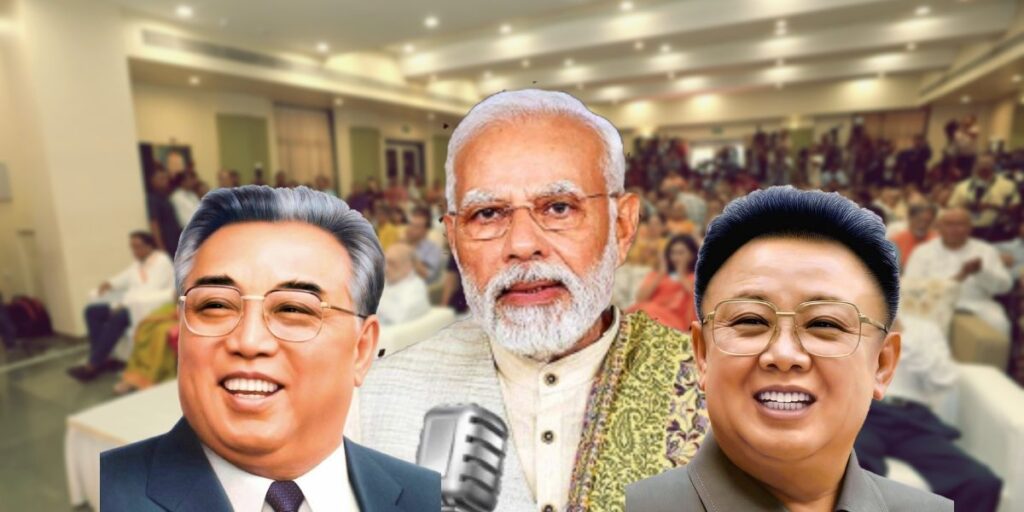When way back in the 1980s Indian newspapers carried the ‘respected and beloved leader’ supplements on Korean despot Kim Il-Sung, we dismissed it with derision. No one had even remotely thought that four decades later, the same phrases will echo to eulogise our own imperious ruler. Look how Amit Shah describes Narendra Modi as India’s ‘most beloved leader’, ‘our inspiration’ and says that the people have ‘unwavering faith in his leadership’.
And ‘respected and beloved’ leader is fast becoming the government’s officialese. The term is increasingly being encouraged by government bodies like the Press Information Bureau. Every event has to be Modi-centric – from the Yoga show to diaspora functions and G-20 and ‘Mann Ki Baat’. In fact, such high-profile events get their importance from their association with the Leader.
This has been the standard toolkit of every despot from Kim Il-Sung to Tayyip Erdogan. Take the G-20. It was not the first time India presided over G-20. It happened in 1999. But unlike Modi, Vajpayee left it to his foreign minister. There were no PM banners, daily advertisements with the PM’s photos and sponsored write-ups on the rise of the ‘Vishwaguru’.
The just concluded ‘Mann ki Baat’ jamboree has surpassed all earlier records in its range, magnitude and scale of mobilisation. There is no way of estimating how much was spent on events. Gujarat AAP president put the figure at Rs 830 crore for which he was slapped with an FIR. The preparations for the 100th episode of ‘Mann Ki Baat’ began early this year. Who says the regime is not democratic? Didn’t it invite ideas from the public on celebrating the great Modi show? The government also sought people’s involvement in composing a jingle for the show and suggest a logo. To enhance public awareness, there was also a quiz programme on how the Leader shaped the nation’s imagination.
Anchored by the PMO, every arm of the state joined Operation ‘Mann Ki Baat’: Union ministries, BJP-ruled states, Indian embassies and high commissions and Raj Bhavans. All with the precision of a hardened absolutist. Nothing was left to chance. Consider these.
- A postal stamp and coin commemorating the 100 episodes were released. And an artist created a micro sculpture of Modi’s bust.
- Vice President Jagdeep Dhankhar released a coffee book ‘Voice of India’, based on the radio programme, published by the information and broadcasting ministry.
- An exhibition of paintings and historical sites mentioned in ‘Mann Ki Baat’ was held in Delhi.
- An exhibition of Amar Chitra Katha comics featuring people and themes mentioned in ‘Mann ki Baat’ and heritage sites mentioned by Modi was held in Delhi. Eminent artists were present to narrate the sequence.
- A daylong discussion was held on nari shakti, a subject mentioned by Modi.
To further amplify the Modi buildup, a national conclave was organised at Vigyan Bhawan four days before his radio talk. Clearly, nine years in power has lured a larger number of artists and neo-intellectuals. Among those who lent their names to the conclave were Aamir Khan, Raveena Tandon, Ricky Kej, Deepa Malik, Nikhat Zareen, Poorna Malavath, and some former governors, including the old adherent Kiran Bedi. Also, friendly celebrities were persuaded to write articles for the mainstream media.
Field surveys and adulatory feedback are other preferred instruments in despots’ toolkits to prop up the leader’s image. In ‘Mann Ki Baat’, we have half a dozen highly publicised surveys, some officially sponsored and others friendly. All of them, invariably, highlighted the Leader’s popularity.
- According to a study by the Rohtak-based Indian Institute of Management, nearly 23 crore people tune in to ‘Mann Ki Baat’ with 65% of them preferring to listen to hear the talk in Hindi. It said 96% of the people are aware of the programme.
- IIM Ranchi will also conduct its own study on ‘Mann Ki Baat’.
- The Institute of Competitiveness in its study found that ‘Mann ki Baat’ has ‘transformed itself into an inspirational platform that is encouraging sustainable progress on priority themes’.
- Another study by the IIMC found that 76% of media persons believe ‘Mann Ki Baat’ played a significant role in introducing the ‘real Bharat’ to the countrymen.
- A survey by the Hyderabad-based National Institute of Rural Development and Panchayat Raj said the programme had a great impact on Modi’s Amrit Sarovar Mission and self-help groups.
All this was ably fortified by the prime minister and his acolytes. “Like Vijay Dashmi,” Modi said, “’Mann ki Baat’ has become a festival of goodness and prosperity.”
Others concurred:
- “This programme, while connecting countrymen through radio, also strengthens the mutual trust and development,” said defence minister Rajnath Singh.
- “‘Mann Ki Baat’ is a unique experiment that has strengthened the foundation of democracy… it is building bridges between people and government,” Union home minister Amit Shah.
- “I wonder whether modern India will ever produce a person who can inspire today’s generation as Rajaram Mohan Roy, Mahatma Gandhi, Vidya Sagar, Phule and Ambedkar,” said BJP president J.P. Nadda.
- “‘Mann ki Baat’ is a reflection of India’s civilisational ethos and will lay the foundation of ‘India at 100’,” said vice president Jagdeep Dhankhar.
- “‘Mann ki Baat’ was instrumental in giving a positive thrust to Ayush,” said Ayush minister Sarbanand Sonowal.
Operation ‘Mann Ki Baat’ was conducted with the precision of a tin-hat despot. Several consulates also joined in, asking people to “celebrate” the 100th episode.
“Don’t miss this on April 30… let us celebrate the landmark 100th episode,” Indian consulate general in New York appealed to the diaspora
“Get ready for the historic moment,” India’s permanent mission to UN prodded.
In the UK, where ministerial colleague Jitendra Singh was the anchor, the ‘entire’ diaspora gathered at the high commission to listen to the episode. It indicated the kind of trust people have in Modi, he said.
Back home, media houses vied with each other to publicise the time and bandwidths of the April 30 radio talk — well in advance.
One of the dailies had as many as seven stories the same day on what it called MKB, short for ‘Mann ki Baat’. In a video released officially, Modi himself could be seen directing the technicians on the nitty-gritty of recording the event.
Consider the mind-boggling statistics. The programme was broadcast in 22 Indian languages and 29 dialects from 500 centres. It was done in 11 foreign languages, including French, Chinese and Arabic.
Three days before the event, Modi himself launched 91 new FM transmitters in 18 states to enlarge the reach of his flagship programme. Apart from the Akashvani networks and private TV channels, 375 private radio operators were also mobilised for the task.
Inmates of jails in friendly states were herded to listen to the Modi speech. Similarly, educational institutions were directed to make students and teachers listen to the Modi show. There were reports of students being punished with fines for not attending the show. Girl students at PGI in Chandigarh were grounded for a week for the same offence.
BJP president J.P. Nadda said that the party had fixed 4 lakh venues to enable people to listen to Modi’s ‘historic’ address. This meant 100 centres in every assembly constituency. Ministers and senior party leaders have been posted at different stations to oversee the arrangements. And certainly, the official feedback has been so enthralling. Over 11 lakh people posted photos of their watching the show. Social media was mobbed with nine lakh tweets with ‘billions’ of impressions registered.
Need any more evidence to prove Modi’s sway over the masses? Look at the photographs officially made available and released by the godi media.
Among these were a bride and groom in Kerala, students in Kashmir, railway workers and porters, Jagdeep Dhankar with film personalities and parents with their children — all avidly listening to the Leader’s ‘Mann Ki Baat’.
(Courtesy: The Wire.)




